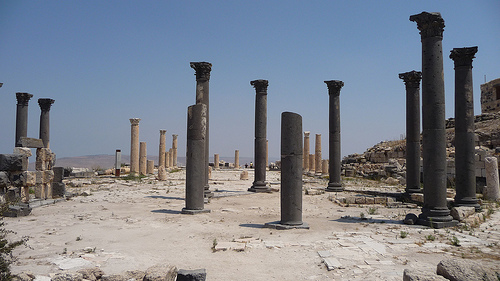

Location: Irbid Governorate Map
Umm Qais or "Mother of Qais" in Arabic is an ancient city in the Irbid Governorate in North- West Jordan. In the ancient times it was known as Gadara. It was even mentioned in the New Testament under this name. Several empires that ruled over these lands left beautiful city with splendid buildings. Gadara or Umm Qais was found in the ancient times, but it began to expand significantly after invasion of Alexander of Macedon. It became part of the Decapolis ("ten cities" in Greek), ten largest Hellenistic cities in the Middle East. In 63 BC Gadara became part of the Roman World. Although it was part lands that belonged to the Jewish king Herod the Great, Romans basically ran the show here.
Gadara (Umm Qais) was mentioned in the New Testament as a "country of Gadarenes" or "Country of the Gerasenes". According to Matthew (8:28-34), Luke (8:26-37) and Mark (5:1-20) Jesus Christ driven the demons out of a man and into a herd of swine. Poor pigs committed suicide by jumping off the cliffs into the sea of Galilee and killing themselves.
During Jewish Revolt Umm Qais become one of the centers of the Jewish resistance. Roman legions marched across desert and captured it and burned it to the ground, killing thousands of defenders and their families.
"So Vespasian marched to the city of Gadara. He came into it and slew all the youth, the Romans having no mercy on any age whatsoever. He set fire to the city and all the villas around it" Josephus. Wars of the Jews, Book 7
Byzantine Period
Umm Qais was rebuilt by subsequent generations of the Roman Empire. During Byzantine period Christian rules ordered construction of an octagonal basalt basilica dedicated to miracles performed by Jesus Christ in these lands. According to a Bible possessed man (who later cured of his ailment) lived on a cemetery outside of city walls in full isolation. Archeological digs discovered remains of older Roman tombs around Christian basilica. It is quiet possible that the place was chosen on this site due to oral tradition that survived among early Christians. And it is theoretically possible that the man who was said to be possessed by demons actually lived here. Basilica became the main church in the Gadara. Several bishops, rulers and other prominent figures were buried in several magnificent tombs that are still visible today.
Umm Qais was badly damaged by an earthquake in 747 AD. Most of structures in Gadara or Umm Qais were badly damaged. City citizens were either killed or began to abandon the settlement. The city ruins escaped quarrying due to low population in the region. Many of the structures were left as they were. Public and religious buildings of Gadara are well preserved despite centuries of neglect.